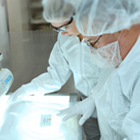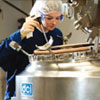Protéines et Peptides
Numéro de catalogue:
(PRSIXW-RP3020)
Fournisseur:
ProSci Inc.
Description:
This protein is a component of vacuolar ATPase (V-ATPase), a multisubunit enzyme that mediates acidification of eukaryotic intracellular organelles. V-ATPase dependent organelle acidification is necessary for such intracellular processes as protein sorting, zymogen activation, and receptor-mediated endocytosis. V-ATPase is comprised of a cytosolic V1 domain and a transmembrane V0 domain. The V1 domain consists of a hexamer of three A and three B subunits plus the C, D, and E subunits. It contains the ATP catalytic site. The protein is known as the E subunit and is found ubiquitously.
UOM:
1 * 50 µG
Numéro de catalogue:
(PRSIXW-RP3196)
Fournisseur:
ProSci Inc.
Description:
POLE3 is a histone-fold protein that interacts with other histone-fold proteins to bind DNA in a sequence-independent manner. These histone-fold protein dimers combine within larger enzymatic complexes for DNA transcription, replication, and packaging
UOM:
1 * 1 EA
Numéro de catalogue:
(PRSIXW-RP3154)
Fournisseur:
ProSci Inc.
Description:
MTCBP-1 is a new member of the Cupin superfamily with a role as an invasion suppressor down-regulated in tumors.
UOM:
1 * 1 EA
Numéro de catalogue:
(PRSI90-317)
Fournisseur:
ProSci Inc.
Description:
Fibroblast growth factors (FGFs) constitute a family of heparin-binding polypeptides involved in the regulation of biological responses such as growth, differentiation and angiogenesis. The biological effects of FGFs are mediated by four structurally related receptor tyrosine kinases denoted FGFR1, FGFR2, FGFR3 and FGFR4. FGF-1 [FGF-acidic; ECGF; HBGF-1] is a powerful mitogen of cells of mesodermal, ectodermal and endodermal origin. FGF-1 association with heparan sulfate is a prerequisite for activation of FGF receptors. FGF-1 plays a role in various stages of development and morphogenesis as well as in angiogenesis and wound healling processes. Recent data indicate a role of FGF-1 in inflammation and obesity. FGF-1 is selectively induced in fat cells by high-fat diet feeding and established the PPARgamma-FGF-1 axis as a critical pathway that regulates adipose tissue remodelling.
UOM:
1 * 1 EA
Numéro de catalogue:
(PRSI92-493)
Fournisseur:
ProSci Inc.
Description:
Thrombopoietin (TPO) is a glycoprotein hormone which belongs to the EPO/TPO family. It produced by the liver and kidney which regulates the production of platelets. TPO stimulates the production and differentiation of megakaryocytes, the bone marrow cells that bud off large numbers of platelets. Lineage-specific cytokine affects the proliferation and maturation of megakaryocytes from their committed progenitor cells. It acts at a late stage of megakaryocyte development. It may be the major physiological regulator of circulating platelets.
UOM:
1 * 50 µG
Numéro de catalogue:
(PRSI92-505)
Fournisseur:
ProSci Inc.
Description:
Human delta(3,5)-Delta(2,4)-dienoyl-CoA isomerase(ECH1) is a member of the hydratase/isomerase superfamily and contains a C-terminal peroxisomal targeting sequence and localises to peroxisomes. ECH1 shows high sequence similarity to enoyl-CoA hydratases of several species, particularly within a conserved domain characteristic of these proteins. The rat orthologlocalises to the matrix of both the peroxisome and mitochondria.It can isomerize 3-trans, 5-cis-dienoyl-CoA to 2-trans,4-trans-dienoyl-CoA, indicating that it is a delta3,5-delta2,4-dienoyl-CoA isomerase. ECH1 plays an important role in the auxiliary step of the fatty acid beta-oxidation pathway.
UOM:
1 * 50 µG
Numéro de catalogue:
(PRSI92-583)
Fournisseur:
ProSci Inc.
Description:
ST2, also called IL-1 R4, is an Interleukin-1 receptor family glycoprotein that plays a role in Th2 immune responses. ST2 is expressed on the surface of mast cells, activated Th2 cells, macrophages, and cardiac myocytes. This receptor is very similar to the IL-1 receptor type I and the IL-18 receptor alpha chain in that ST2 also has three extracellular Ig domains and an intracellular Toll domain. ST2 binds IL-33, enhances inflammatory cytokines by activating nuclear factor-κB (NF-κB) and mitogen activated protein (MAP) kinases. ST2 exists as either a membrane bound form (ST2L) or as a soluble form (sST2). ST2L acts as a transmembrane signalling receptor for IL-33 by mediating the effect of IL-33 on the inflammatory process, while sST2 can suppress IL-33 activity.
UOM:
1 * 50 µG
Numéro de catalogue:
(PRSI91-154)
Fournisseur:
ProSci Inc.
Description:
Stathmin (STMN1) is a ubiquitous cytosolic phosphoprotein which belongs to the Stathmin family. STMN1 is expressed in many tissues, with the highest expression in the brain, spinal cord, and cerebellum. It can also be expressed in the colon, ovary, placenta, uterus, and trachea. STMN1 participates in the regulation of the microtubule filament structure by destabilizing microtubules. STMN1 promotes the disassembly of microtubules and prevents assembly. STMN1 is involved in the control of the learned and innate fear. STMN1 is an intracellular relay integrating regulatory signals of the cellular environment and as an Oncoprotein in regulation of the cell cycle. Phosphorylation at Ser-16 may be required for axon formation during neurogenesis. Mutation in STMN1 effects cell homeostasis that may lead to tumorigenicity.
UOM:
1 * 50 µG
Numéro de catalogue:
(PRSI91-155)
Fournisseur:
ProSci Inc.
Description:
Small Ubiquitin-Related Modifier 1 (SUMO1) is an Ubiquitin-like protein that belongs to the ubiquitin family with SUMO subfamily. It is a family of small, related proteins that can be enzymatically attached to a target protein by a post-translational modification process termed sumoylation. SUMO1 functions in a manner similar to ubiquitin in that it is bound to target proteins as part of a post-translational modification system. This post-translational modification on lysine residues of proteins plays a crucial role in a number of cellular processes such as nuclear transport, DNA replication and repair, mitosis and signal transduction. SUMO1 is involved in a variety of cellular processes, such as nuclear transport, transcriptional regulation, apoptosis, and protein stability. SUMO1 is not active until the last four amino acids of the carboxy-terminus are cleaved off. Polymeric SUMO1 chains are also susceptible to polyubiquitination which functions as a signal for proteasomal degradation of modified proteins and may also regulate a network of genes involved in palate development.
UOM:
1 * 50 µG
Numéro de catalogue:
(PRSI2267P)
Fournisseur:
ProSci Inc.
Description:
AIF peptide is used for blocking the activity of AIF antibody.
UOM:
1 * 50 µG
Numéro de catalogue:
(PRSI2261P)
Fournisseur:
ProSci Inc.
Description:
SkiP peptide is used for blocking activity of SkiP antibody.
UOM:
1 * 50 µG
Numéro de catalogue:
(PRSI90-023)
Fournisseur:
ProSci Inc.
Description:
FABP4 is a fatty acid binding protein in adipocytes. Fatty acid binding proteins are a family of small, highly conserved, cytoplasmic proteins that bind long-chain fatty acids and other hydrophobic ligands. FABPs regulate the fatty acid uptake, transport, and metabolism. aP2, the mouse form of FABP4, seems to be central to the pathway that links obesity to insulin resistance. aP2 was shown to be an adipokine linking adipocytes to hepatic glucose production and that neutralising secreted aP2 may represent an effective therapeutic strategy against diabetes.
UOM:
1 * 50 µG
Numéro de catalogue:
(PRSI90-032)
Fournisseur:
ProSci Inc.
Description:
Interleukin-33 (IL-33; HF-NEV; IL-1F11), a member of the IL-1 family of cytokines, is expressed by many cell types following pro-inflammatory stimulation and is thought to be released on cell lysis. The 30kDa human IL33 is converted by CASP1 to a 18kDa protein. IL33 binds to and signals through ST2 (IL1R1) and its stimulation recruits MYD88, IRAK, IRAK4, and TRAF6, followed by phosphorylation of ERK1 (MAPK3)/ERK2 (MAPK1), p38 (MAPK14), and JNK. The ability of IL-33 to target numerous immune cell types, like Th2-like cells, mast cells, and B1 cells, and to induce cytokine and chemokine production underlines its potential in influencing the outcome of a wide range of diseases, such as arthritis, asthma, atopic allergy & anaphylaxis, cardiovascular disease/atherosclerosis, nervous system diseases, and sepsis.
UOM:
1 * 1 EA
Numéro de catalogue:
(PRSI90-037)
Fournisseur:
ProSci Inc.
Description:
Retinol binding protein 4 (RBP4; RBP) is a 21kDa secreted protein, a member of the lipocalin family and is known as the primary transporter of retinol (vitamin A) to tissues. A recent report revealed RBP4 as an adipokine linking glucose transporter 4 (GLUT4) suppression in adipose tissue to insulin. Elevated human and mouse serum RBP4 levels are associated with insulin resistance and its severity, obesity, and certain components of metabolic syndrome. Furthermore, human serum RBP4 levels are closely related to renal function.
UOM:
1 * 50 µG
Numéro de catalogue:
(PRSI96-030)
Fournisseur:
ProSci Inc.
Description:
Anexin A5 is a phospholipid binding protein, which binds with high affinity and selectivity to PS in the presence of calcium. PS is predominantly located in membrane leaflets, which face the cytosol. However, recent findings show that each cell type has the molecular machinery to expose PS at its cell surface. This machinery is activated during the execution of apoptosis. Once PS is exposed at the cell surface it exhibits procoagulant and proinflammatory activities. Anexin A5 will bind to the PS-exposing apoptotic cell and can inhibit the procoagulant and proinflammatory activities of the dying cell. Anexin A5 has also been identified as an anticoagulant protein in the blood coagulation cascade, by acting as an inhibitor of prothrombin activation. The presence of antibodies to Anexin A5 is associated with systemic lupus erythematosus (SLE), recurrent spontaneous abortions and systemic sclerosis (SSc).
UOM:
1 * 1 EA
Numéro de catalogue:
(PRSI4561P)
Fournisseur:
ProSci Inc.
Description:
CAPS1 peptide is used for blocking the activity of CAPS1 antibody.
UOM:
1 * 50 µG
Appel de prix
Le stock de cet article est limité mais peut être disponible dans un entrepôt proche de vous. Merci de vous assurer que vous êtes connecté sur le site afin que le stock disponible soit affiché. Si l'
Le stock de cet article est limité mais peut être disponible dans un entrepôt proche de vous. Merci de vous assurer que vous êtes connecté sur le site afin que le stock disponible soit affiché. Si l'
Ces articles ne peuvent être ajoutés au Panier. Veuillez contacter votre service client ou envoyer un e-mail à vwr.be@vwr.com
Une documentation supplémentaire peut être nécessaire pour l'achat de cet article. Un représentant de VWR vous contactera si nécessaire.
Ce produit a été bloqué par votre organisation. Contacter votre service d'achat pour plus d'informations.
Le produit original n'est plus disponible. Le remplacement représenté est disponible
Les produits marqués de ce symbole ne seront bientôt plus disponibles - vente jusqu'à épuisement de stock. Des alternatives peuvent être disponibles en recherchant le code article VWR indiqué ci-dessus. Si vous avez besoin d'une assistance supplémentaire, veuillez contacter notre Service Clientèle au 016 385 011.
|
|||||||||
















































